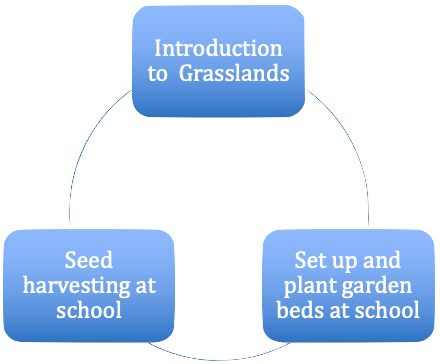Seeds from Schools
The Seeds from Schools program arises from the Seeds from the Streets project that was developed by Victoria University. This project was founded on the identified need for an abundant source of seed that could be used for native grassland restoration projects in the west of Melbourne, without overharvesting from naturally occurring plant populations.
The Seeds from Schools program aims to introduce school students to the unique nature of a grassland environment and for students to actively participate in a hands-on project. The Seeds from Schools program provides a circular learning approach that can cycle each year:

Students will participate in three sessions with an Ecolinc Environmental Educator. They will learn about the importance of the grassland environment and its biota; grow a crop of the threatened grassland plants in a garden bed in the school grounds (prepared by the school); maintain and eventually harvest the seed from this crop; and participate in habitat restoration activities, which may include sowing of the seed that they have harvested.
Schools must be prepared to do the following:
- Allocate and prepare a site at your school to plant the grassland plants. This could include garden bed or raised garden beds. Please supply adequate soil and mulch. This could be sourced from your local council.
-
Participate in three days:
- Day 1: At Ecolinc – Introduction to grasslands (either term 1 or 2)
- Day 2: At school – Plant out garden beds (garden beds will need to be prepared prior to this day) (either term 2 or 3)
- Day 3: At school - Seed harvesting at school (term 4)
Note:
- Maximum number of students for this program is 50 per day.
Key Learning Question
What is the importance of grasslands?
Learning Intentions
In this program students will:
- Understand the terms grassland, ecosystem, indigenous, biodiversity, predator and prey
- Demonstrate how plants and animals depend on each other and the environment to survive
- Learn how indigenous plants provide shelter, food and nest sites for native animals
- Propagate indigenous plants
Activities
Students will participate in this program over three separate days throughout the year:
- Learn about the importance of grasslands and their threats
- Understand the interdependence between of animals and grassland habitats
- Propagate indigenous plants from seeds and cuttings
- Plant out garden beds at school with indigenous plants
- Collect indigenous seed and store for future propagation
- Play a game which reinforces concepts of predator/prey relationships and highlights the issues of conservation and habitat destruction
Victorian Curriculum
Science – Biological sciences
- Living things have structural features and adaptations that help them to survive their environment (VCSSU074)
- The growth and survival of living things are affected by the physical conditions of their environment (VCSSU075)

